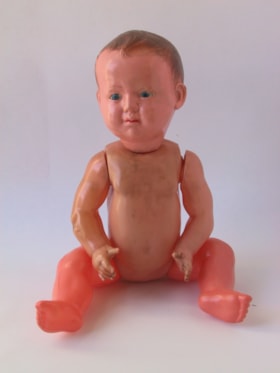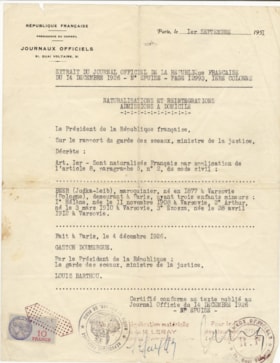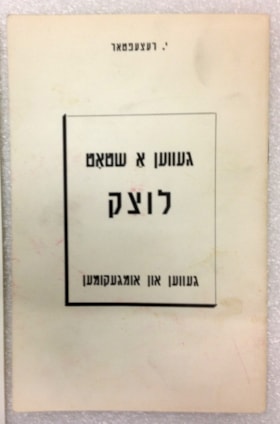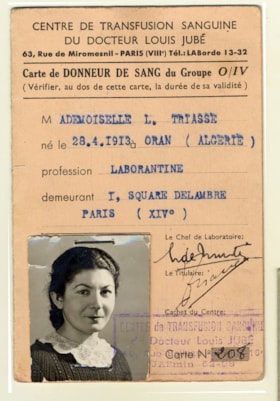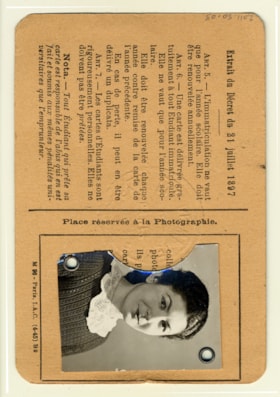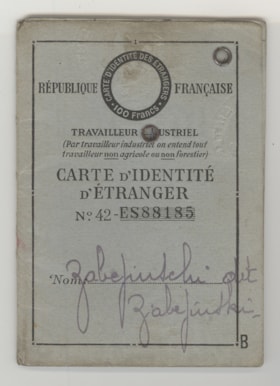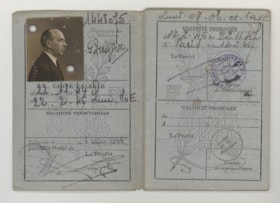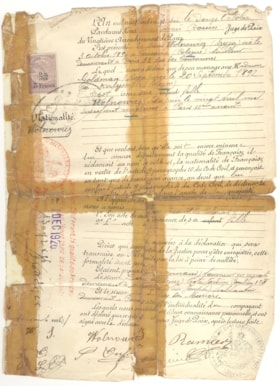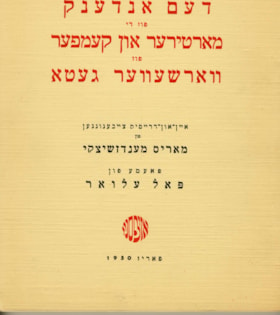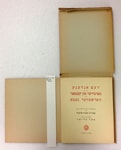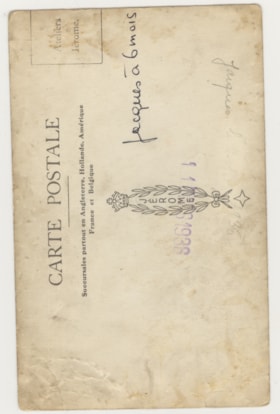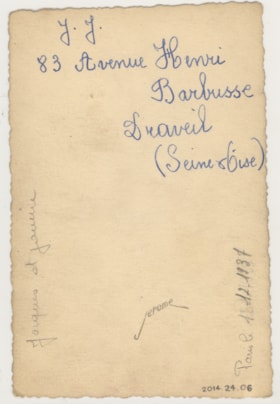Doll
https://www.cjhn.ca/link/cjhn50276
- Collection
- Montreal Holocaust Museum
- Description Level
- Item
- Material Type
- object
- Physical Description
- Doll : Pink, Brown, Blue, Red ; Ht: 14 in. x W: 6,5 in.
- Collection
- Montreal Holocaust Museum
- Description Level
- Item
- Material Type
- object
- Physical Description
- Doll : Pink, Brown, Blue, Red ; Ht: 14 in. x W: 6,5 in.
- Other Title Information
- Toy
- Physical Condition
- Good
- Notes
- Plastic baby doll with articulated legs and arms. Pink skin colour. Details for hair are engraved on the head and coloured brown. Eyes are coloured blue. Legs are a redder shade of pink while torso and arms' tone is closer to skin colour. Narrative: Donor Marguerite received this doll from her father just before his deportation. She was five years old. Marguerite and her sister left Paris and were taken care in hiding by Catholic farmers in the region of Grenoble, France. they stayed there between 1942 and 1944. Marguerite always kept the doll with her. After the liberation of Paris, the farmer who took care of the girls was accused of being a collaborator and the girls' mother came to get them. On a French train, a French soldier picked up the doll and burned its arm witha cigarette and poked its eye out saying "now it's wounded like the rest of us”. After Marguerite came to Montreal, married and became pregnant, her mother had the doll repaired and sent to her.
- Accession No.
- 2011X.53.01
- Name Access
- Elias, Marguerite
- Places
- Paris?, France, Europe
- Archival / Genealogical
- Archival Descriptions
- Repository
- Montreal Holocaust Museum
Images
En souvenir de nos rabbins et ministres officiants victimes de la barbarie nazie
https://www.cjhn.ca/link/cjhn51257
- Collection
- Montreal Holocaust Museum
- Description Level
- Item
- Material Type
- textual record
- Physical Description
- Book : Paper : Ink : Black, White ; Ht: 9 in. x W: 6,25 in.
- Date
- 1946
- Collection
- Montreal Holocaust Museum
- Description Level
- Item
- Material Type
- textual record
- Physical Description
- Book : Paper : Ink : Black, White ; Ht: 9 in. x W: 6,25 in.
- Other Title Information
- Documentary Artifact
- Date
- 1946
- Creator
- -
- Physical Condition
- Good
- Language
- French
- Notes
- Border around cover
- Accession No.
- 2011X.58.203
- Name Access
- MHMC
- Places
- Paris, France, Europe
- Archival / Genealogical
- Archival Descriptions
- Repository
- Montreal Holocaust Museum
Images
Extrait du Journal officiel de la République française du 14 décembre 1926 - N Epuisé - Page I2993, 1ere colonne
https://www.cjhn.ca/link/cjhn76680
- Collection
- Montreal Holocaust Museum
- Description Level
- Item
- Material Type
- textual record
- Physical Description
- Certificate : paper ; Ht: 27,6 cm x W: 21,5 cm
- Date
- September 01, 1951
- Collection
- Montreal Holocaust Museum
- Description Level
- Item
- Material Type
- textual record
- Physical Description
- Certificate : paper ; Ht: 27,6 cm x W: 21,5 cm
- Other Title Information
- Documentary Artifact
- Date
- September 01, 1951
- Physical Condition
- Poor
- Language
- French
- Notes
- Certificate attesting that Judka-Leib Beer and his three children are naturalized French citizens. The document is printed in black ink. A postage stamp is found on the bottom left of the document. The stamp says Taxes Communales, 10 Francs. Narrative: Judka-Leib Beer was born in 1877 in Warsaw. He was married to Liba Gudrot and had three children named Hélène, Arthur and Ezosza. He was the donor's grandfather.
- Accession No.
- 2012.20.01
- Name Access
- Allen, Stéphane John
- Places
- Paris, France, Europe
- Archival / Genealogical
- Archival Descriptions
- Repository
- Montreal Holocaust Museum
Images
Geven a Shtot in Lutsk ?
https://www.cjhn.ca/link/cjhn47895
- Collection
- Montreal Holocaust Museum
- Description Level
- Item
- Material Type
- textual record
- Physical Description
- Booklet : printed, bound : white, black ; Ht: 21,2 cm x W: 13,6 cm
- Collection
- Montreal Holocaust Museum
- Description Level
- Item
- Material Type
- textual record
- Physical Description
- Booklet : printed, bound : white, black ; Ht: 21,2 cm x W: 13,6 cm
- Other Title Information
- Documentary Artifact
- Physical Condition
- Good
- Language
- Yiddish
- Notes
- 15 pages. Softcover, cardstock bound with staples. Cover is white with black text, surrounded by a thin rectangular border. Interior pages are white with text. Narrative: The pamphlet is about the Jews in Lutsk. Belonged to Mordecai Szteinfeld.
- Accession No.
- 2001.61.07
- Name Access
- Meltzer, Riva
- Places
- Paris, France, Europe
- Archival / Genealogical
- Archival Descriptions
- Repository
- Montreal Holocaust Museum
Images
Identification and travel pass
https://www.cjhn.ca/link/cjhn76484
- Collection
- Montreal Holocaust Museum
- Description Level
- Item
- Material Type
- textual record
- Physical Description
- Identification and travel pass : Cardboard : Printed, Handwritten : Ink : Blue, Black, Red, Green, White ; Ht: 12,5 cm x W: 9 cm
- Date
- January 11, 1949
- Collection
- Montreal Holocaust Museum
- Description Level
- Item
- Material Type
- textual record
- Physical Description
- Identification and travel pass : Cardboard : Printed, Handwritten : Ink : Blue, Black, Red, Green, White ; Ht: 12,5 cm x W: 9 cm
- Other Title Information
- Documentary Artifact
- Date
- January 11, 1949
- Physical Condition
- Good
- Language
- French
- Notes
- 1 horizontal page, folded vertically 9 times to create 10 double-sided panels. When folded, document is an 18-page booklet, not including front and back covers. Front cover has thick red diagonal stripes printed at top left and bottom right corners. White circular sticker affixed at top left corner under stripe with handwritten annotation "4 / D. Hal". Document is an identification and travel pass for Mayer Abramowicz, issued by the state of France in lieu of a passport. Numbered 00077. Square b&w photograph of subject affixed on page 3 with 2 metal grommets. Valid for 1 year, until January 10, 1950. Visas on pages 7,8,9, and 10 related to subject's immigration to Canada in 1949. Back cover has 60174 handwritten in black ink at top right corner. Narrative: Bella (Beila, Bela) Herling and Mayer (Majer, Meyer, Meir) Abramovitch (Abramovitz, Abramowicz, Abramowitz) were the parents of the donor, Toby Herscovitch. Bella was born in Suchedniów, Poland on September 25, 1925, the youngest of a family of ten children. Her parents and five siblings were murdered in the Holocaust. Bella and three of her sisters survived the war working as slave labourers in an ammunitions factory in Skarzysko-Kamienna. They were liberated by Russian troops on January 16, 1945, and made their way to the Feldafing Displaced Persons Camp, where they reunited with a brother who had survived Auschwitz. Bella volunteered for nursing training by a Jewish refugee agency, and worked as a nurse in the camp from 1946 to 1948. In 1948, she joined her sister Paula in Toronto, where she worked as a nurse's aide and married Mayer, a fellow survivor who she had known from Feldafing. Born November 10, 1914 in Vilna (Vilnius), he was the sole survivor of a family of six children. He lived in the Vilna ghetto and worked in a factory making window panes for German barracks; he was later sent to a labour camp in Tallin, Estonia, and then to Stutthof concentration camp. In the final days of the war, he escaped from a subsequent transfer to Dachau concentration camp and was liberated. He spent three months sick in a hospital and ended up in Feldafing, where he was active in the "Amchu" or "AMCHO" theater group, part of the Jewish Labour Committee. He lived for a year in France, and immigrated to Canada in May, 1949. Bella and Mayer moved to Montreal in 1950 and opened a fabric store. Mayer passed away in 2001, and Bella in 2014.
- Accession No.
- 2014.10.09
- Name Access
- Herscovitch, Toby
- Places
- Paris, France, Europe
- Archival / Genealogical
- Archival Descriptions
- Repository
- Montreal Holocaust Museum
Images
Identification card
https://www.cjhn.ca/link/cjhn45718
- Collection
- Montreal Holocaust Museum
- Description Level
- Item
- Material Type
- textual record
- Physical Description
- Identification card : Ht: 12 cm x W: 16 cm
- Date
- January 5, 1944-July 13, 1944
- Collection
- Montreal Holocaust Museum
- Description Level
- Item
- Material Type
- textual record
- Physical Description
- Identification card : Ht: 12 cm x W: 16 cm
- Other Title Information
- Documentary Artifact
- Date
- January 5, 1944-July 13, 1944
- Physical Condition
- Good
- Language
- French
- Notes
- beige cardstock card folded in two with stapled b&w identity picture on the front page. Printed in black with two handwritten signatures and one purple stamp on the front page. Dates of transfusions on the inside and dates of medical exams on the back page. Narrative: Lonia Furstenberg was born on 1914-04-28 in Belchatow (Poland) to Meier Furstenberg and Asha Biblow. She left Poland at the age of 16 to study medicine in Paris (quotas in Poland made it hard for her to pursue her studies). Lonia’s family was German speaking; she also spoke Polish and Yiddish. She had no family in France. She lived in Nancy and Reims before establishing herself in Paris. She learned French while working as a laboratory assistant. She then studied medicine and took classes in all the specialties, but for military medicine. Military medicine required students to lean how to jump out of an helicopter which her father would not give her permission to do. During the Second World War, she was a medicine student and worked in a clinic requisitioned by the German army. She passed as a non Jewish French citizen and had fake identity paper made to the name of Louise Triasse, supposedly born in Oran. Her resistance activities included caring for wounded resistant fighters, issuing fake disease certificated to young men so they could be exempt for the mandatory labour service (STO service du travail obligatoire) and issuing certificate of good health to prostitutes carrying venereal diseases who wanted to infect German soldiers. She became the first woman to own her own medical laboratory. Lonia was a Communist sympathizer, she was not religious and she eventually married a Gentile, a Polish RAF pilot named Zigmunt Kawnik (born in 1920). All the members of Lonia's family in Poland were deported and killed during the Holocaust.
- Accession No.
- 2011.50.02
- Name Access
- Allio, Nicole
- Places
- Paris, France, Europe
- Archival / Genealogical
- Archival Descriptions
- Repository
- Montreal Holocaust Museum
Images
Identification card
https://www.cjhn.ca/link/cjhn45719
- Collection
- Montreal Holocaust Museum
- Description Level
- Item
- Material Type
- textual record
- Physical Description
- Identification card : Ht: 12,7 cm x W: 8,9 cm
- Date
- 1945-1946
- Collection
- Montreal Holocaust Museum
- Description Level
- Item
- Material Type
- textual record
- Physical Description
- Identification card : Ht: 12,7 cm x W: 8,9 cm
- Other Title Information
- Documentary Artifact
- Date
- 1945-1946
- Physical Condition
- Good
- Language
- French
- Notes
- beige cardstock identification card with b&w photograph of Lonia Furstenberg on the back page. Printed in black with two handwritten signatures on the front page (Lonia Furstenberg and the secretary of the faculty of medecine). School seal pressed onto the back page (faculté de médecine) and a short excerpt from the decree of July 21, 1897. Narrative: Lonia Furstenberg was born on 1914-04-28 in Belchatow (Poland) to Meier Furstenberg and Asha Biblow. She left Poland at the age of 16 to study medicine in Paris (quotas in Poland made it hard for her to pursue her studies). Lonia’s family was German speaking; she also spoke Polish and Yiddish. She had no family in France. She lived in Nancy and Reims before establishing herself in Paris. She learned French while working as a laboratory assistant. She then studied medicine and took classes in all the specialties, but for military medicine. Military medicine required students to lean how to jump out of an helicopter which her father would not give her permission to do. During the Second World War, she was a medicine student and worked in a clinic requisitioned by the German army. She passed as a non Jewish French citizen and had fake identity paper made to the name of Louise Triasse, supposedly born in Oran. Her resistance activities included caring for wounded resistant fighters, issuing fake disease certificated to young men so they could be exempt for the mandatory labour service (STO service du travail obligatoire) and issuing certificate of good health to prostitutes carrying venereal diseases who wanted to infect German soldiers. She became the first woman to own her own medical laboratory. Lonia was a Communist sympathizer, she was not religious and she eventually married a Gentile, a Polish RAF pilot named Zigmunt Kawnik (born in 1920). All the members of Lonia's family in Poland were deported and killed during the Holocaust.
- Accession No.
- 2011.50.03
- Name Access
- Allio, Nicole
- Places
- Paris, France, Europe
- Archival / Genealogical
- Archival Descriptions
- Repository
- Montreal Holocaust Museum
Images
Identification card
https://www.cjhn.ca/link/cjhn50268
- Collection
- Montreal Holocaust Museum
- Description Level
- Item
- Material Type
- textual record
- Physical Description
- Identification card : Paper : Ink : Green, Red, White, Black ; Ht: 5 in. x W: 3,5 in.
- Date
- September 11, 1940
- Collection
- Montreal Holocaust Museum
- Description Level
- Item
- Material Type
- textual record
- Physical Description
- Identification card : Paper : Ink : Green, Red, White, Black ; Ht: 5 in. x W: 3,5 in.
- Other Title Information
- Documentary Artifact
- Date
- September 11, 1940
- Physical Condition
- Poor
- Language
- French
- Notes
- 1 page, card folded into three vertical panels. On the inside of the first panel is a b&w portrait of Sara Fiszman nee Finkelstein, born in 1873. Three stamps on the inside, as well as two fingerprints. Inside page is stamped with mention "JUIVE", identifying Sara as Jewish. The card is an identification card for foreigners living in France with non-rowker status.
- Accession No.
- 1998.19.03
- Name Access
- Myers, Muguette
- Places
- Paris, France, Europe
- Archival / Genealogical
- Archival Descriptions
- Repository
- Montreal Holocaust Museum
Images
Identification card
https://www.cjhn.ca/link/cjhn59814
- Collection
- Montreal Holocaust Museum
- Description Level
- Item
- Material Type
- textual record
- Physical Description
- Identification card : Cardstock : Printed, handwritten : Ink : Blue, black, beige. ; Ht: 13 cm x W: 86 cm
- Date
- 1939-December 04, 1944
- Collection
- Montreal Holocaust Museum
- Description Level
- Item
- Material Type
- textual record
- Physical Description
- Identification card : Cardstock : Printed, handwritten : Ink : Blue, black, beige. ; Ht: 13 cm x W: 86 cm
- Other Title Information
- Documentary Artifact
- Date
- 1939-December 04, 1944
- Physical Condition
- Good
- Language
- French
- Notes
- Single length of cardstock divided into nine panels by evenly-spaced creases, b&w photo of cardholder on first panel, stamped by the Prefecture of Police from the Direction des Etrangers. Issued to Gregory Zabejinski (born March 23, 1879 in Ismail, Ukraine). Space for visas, personal information, and other relevant data. Narrative: Gregory Hirsch Braude (donor’s father) was born in Smorgon, near Riga, Latvia, on May 23, 1900. Between that time and 1920, his family had moved to Berlin, Germany. Vera Braude, née Zabejinski, was born in Moscow, Russia, in 1908. In 1920, Vera’s family moved to Berlin, Germany. Gregory met Vera Zabejinski (born on June 23, 1908, in Moscow) at a masked ball in 1929 and then got married. They remained in Berlin until the spring of 1938 and moved to Paris, France. Their daughter, Marina was born there on January 17, 1940. Around 1941, Gregory, Vera, their daughter Marina, and Johanan (one of Gregory’s elder brothers) escaped Paris towards Marseilles. Then they were smuggled out to Lisbon, Portugal. While in Lisbon, the family got visas for Cuba and left for Havana aboard the Serpa Pinto. They remained there for approximately six months. The family later moved to New York City after Gregory got a visa for the United States. He and Vera had a son, Alexander, in New York in 1946. In New York, Gregory and Johanan established a business, Braude Brothers Leather Tanning Corporation, while Vera was an artist and a homemaker. Vera’s parents, Rosa Zabejinski (née Belkin, on May 24, 1885) and Gregory Zabejinski (born on March 23, 1879), had joined them in Paris, while her sister, Rufina ("Ina"), hid in a fishing village in France. Rufina had married Marc Beaucourt, a non-Jewish Frenchman. Rufina’s in-laws, the Beaucourt, had arranged to build a hidden room behind their daughter Lydie’s room for Rosa and Gregory to hide into.
- Accession No.
- 2006.24.12
- Name Access
- Etingin, Marina
- Places
- Paris, France, Europe
- Archival / Genealogical
- Archival Descriptions
- Repository
- Montreal Holocaust Museum
Images
Identification card
https://www.cjhn.ca/link/cjhn78443
- Collection
- Montreal Holocaust Museum
- Description Level
- Item
- Material Type
- textual record
- Physical Description
- Identification card : Paper : Ink : beige, black ; Ht: 8 cm x W: 12 cm
- Date
- June 27, 1952
- Collection
- Montreal Holocaust Museum
- Description Level
- Item
- Material Type
- textual record
- Physical Description
- Identification card : Paper : Ink : beige, black ; Ht: 8 cm x W: 12 cm
- Other Title Information
- Documentary Artifact
- Date
- June 27, 1952
- Physical Condition
- Good
- Language
- French
- Notes
- 1 page. Two-sided document issued by the "Ministère des anciens combattant et victimes de la guerre". On the l. is a picture of woman (Marianne, allegory of the French Republic) down on one knee extending her arms toward two children with the inscription "Pupilles de la Nation", or warden of the State, under the image. On the verso are the details about the 1917-07-27 law concerning children affected by war. After the Second World War, Jewish children were adopted by the French Nation as they received help and protection if needed. Narrative: Jacques Kasma was born Jacques Kaszemacher on 1935-09-04 in the 10th arrondissement of Paris (France). His father was Uszer Hersz Kaszemacher, also known as Henric Kasmacher, born on 1913-04-05 in Parczew (Poland). His mother was Chaja Sura Bajwelcwajg, born 1915-05-19 in Warsaw (Poland). Jacques had a younger sister, Jeannine, born in 1937. In 1940, Henri Kasmacher was a driver in the French army. He was captured by the German armed forces in Saint-Die-des-Vosges (France) and was deported to the forced labour camp of Brunswiek, a subcamp of Neuengamme concentration camp ( Germany). In 1943, Chaja Bajwelcwajg was arrested and interned at the Drancy transit camp (France). She died in Drancy on 1943-09-02. Jacques was hidden in Normandy (France) during the war. After Liberation, he spent time in an orphanage ran by the OSE in Le Vésinet. He met Marcel Marceau, a famous French mime, who taught him his art. Henri Kasmacher survived the war and came back to France and remarried to Ida Wolnowicz. In 1956, Jacques Kasma settled in Montreal (Canada) where he pursued an artistic career. He acted as a mime named Tit-Bo on the children's television program "La Boîte à Surprise". He worked at the National Film Board as an editor and director. He also worked with the filmmaker Gilles Groulx. He went back to France to fulfill his military service obligations and moved back to Montreal in 1960. He was part of the Douglas hospital psychiatric research team for 20 years.
- Accession No.
- 2014.24.14
- Name Access
- Kasma, Puck
- Places
- Paris, France, Europe
- Archival / Genealogical
- Archival Descriptions
- Repository
- Montreal Holocaust Museum
Images
Identification certificate
https://www.cjhn.ca/link/cjhn78449
- Collection
- Montreal Holocaust Museum
- Description Level
- Item
- Material Type
- textual record
- Physical Description
- Identification certificate : Paper : printed, handwritten : Ink : off-white, black, purple, red ; Ht: 24,4 cm x W: 7,5 cm
- Date
- December 01, 1926
- Collection
- Montreal Holocaust Museum
- Description Level
- Item
- Material Type
- textual record
- Physical Description
- Identification certificate : Paper : printed, handwritten : Ink : off-white, black, purple, red ; Ht: 24,4 cm x W: 7,5 cm
- Other Title Information
- Documentary Artifact
- Date
- December 01, 1926
- Physical Condition
- Poor
- Language
- French
- Notes
- 1 page. One-sided official document issued by the Minister of Justice. On the t.l. is a purple fiscal stamp of 3 Francs. The document states the french nationality of Ida Wolnowicz. Narrative: Ida Wolnowicz was born in Paris on 1925-04-20. She was the daughter of Szypa Wolnowicz, born 1894-10-03 in Warsaw (Poland) and Rojza Goldmann born 1892-09-20 in Kaluszyn (Poland). Ida's parents and her brother Lejb Nuta Wolnowicz were arrested in Paris on 1942-07-16 and sent to Drancy internment camp (France). They were deported to Auschwitz on 1942-07-22 where they were killed. Ida Wolnowicz survived the Holocaust and came back to Paris where she married Uszer Kaszemacher and adopted his son Jacques Kaszemacher.
- Accession No.
- 2014.24.21
- Name Access
- Kasma, Puck
- Places
- Paris, France, Europe
- Archival / Genealogical
- Archival Descriptions
- Repository
- Montreal Holocaust Museum
Images
Identification certificate
https://www.cjhn.ca/link/cjhn78453
- Collection
- Montreal Holocaust Museum
- Description Level
- Item
- Material Type
- textual record
- Physical Description
- Identification certificate : Paper : printed, handwritten : Ink : off-white, black, blue, purple ; Ht: 26,8 cm x W: 20,9 cm
- Date
- November 26, 1946
- Collection
- Montreal Holocaust Museum
- Description Level
- Item
- Material Type
- textual record
- Physical Description
- Identification certificate : Paper : printed, handwritten : Ink : off-white, black, blue, purple ; Ht: 26,8 cm x W: 20,9 cm
- Other Title Information
- Documentary Artifact
- Date
- November 26, 1946
- Physical Condition
- Good
- Language
- French
- Notes
- 1 page. One-sided form issued by the Ministry of population for Uszer Kaszemacher. The document testities to Uszer Kaszemacher French naturalization. Narrative: Uszer Kaszemacher, also known as Henric Kasmacher, was born on 1913-04-05 in Parczew (Poland). He was a driver in the French Army starting in 1940-03. He was captured in 1940-06 in Saint-Die-des-Vosges (France) and was deported to the forced labour camp of Brunswiek, a subcamp of Neuengamme concentration camp ( Germany). He survived the war and went back to France where he was remarried to Ida Wolnowicz.
- Accession No.
- 2014.24.25
- Name Access
- Kasma, Puck
- Places
- Paris, France, Europe
- Archival / Genealogical
- Archival Descriptions
- Repository
- Montreal Holocaust Museum
Images
In Memory of the Martyrs and Fighters of the Warsaw Ghetto [Translation]
https://www.cjhn.ca/link/cjhn47880
- Collection
- Montreal Holocaust Museum
- Description Level
- Item
- Material Type
- textual record
- Physical Description
- Book : printed, bound, graphic arts : beige, red, black, gold ; Ht: 27,4 cm x W: 21,8 cm
- Date
- 1950
- Collection
- Montreal Holocaust Museum
- Description Level
- Item
- Material Type
- textual record
- Physical Description
- Book : printed, bound, graphic arts : beige, red, black, gold ; Ht: 27,4 cm x W: 21,8 cm
- Other Title Information
- Documentary Artifact
- Date
- 1950
- Creator
- -
- Physical Condition
- Poor
- Language
- Hebrew
- French
- Notes
- Approximately 78 pages. Softcover, paper bound. Cover is textured beige with red and black text; the text at the bottom centre is in the shape of a circle; the back cover is plain beige. Approximately the first 10 pages have text only; the remaining pages each have a b&w illustrations of people. The book is housed in a cardboard book box, which has 2 flaps put together to form a box. The box is textured beige and red-brown. The title is gilded along the spine.
- Accession No.
- 2005.21.02
- Places
- Paris, France (Europe)
- Archival / Genealogical
- Archival Descriptions
- Repository
- Montreal Holocaust Museum
Images
Invitation
https://www.cjhn.ca/link/cjhn49912
- Collection
- Montreal Holocaust Museum
- Description Level
- Item
- Material Type
- textual record
- Physical Description
- Invitation : Paper : Beige, black ; Ht: 9 cm x W: 28 cm
- Date
- March 06, 1938
- Collection
- Montreal Holocaust Museum
- Description Level
- Item
- Material Type
- textual record
- Physical Description
- Invitation : Paper : Beige, black ; Ht: 9 cm x W: 28 cm
- Other Title Information
- Documentary Artifact
- Date
- March 06, 1938
- Physical Condition
- Good
- Language
- French
- Notes
- One page folded in two. Deckled edges. Narrative: In the 1920’s Serge and Sophie Philipson (nee Orbach) left Berlin for Paris due to rising antisemitism. On July 15, 1930 their daughter Rachel was born. Serge, Sophie and Rachel were Polish citizen, they never got either the German or the French citizenship. In Paris, Serge worked for Les Modes Modernes, the hat factory of his brother-in-law, Henri. When an opportunity to expand the business in Ireland arose, Serge moved to Galway. The new factory opened in July 1938. In August 1939, Sophie, Rachel, and 4 other family members (Rachel’s cousin Stéphane, his maternal grandmother Néné, Serge’s sister Esther and Serge’s sister-in-law Choura) left for Cabourg, in Normandy. After the winter 1939-1940 it became difficult to communicate with Ireland but Rachel and Sophie could still send and receive letter from Serge. At the end of winter 1940, the group moved to Néris and in July 1940, after the occupation of France by Germany, they settled in the zone libre in the village of Cauterets, on the border with Spain. They were reunited with Robert, Serge’s brother. In August 1942, 4 family members (Sophie’s sister Ella and her husband Ernest, their daughter Ruth, Serge’s siblings Robert and Esther) were arrested by local police and deported. They were not seen again. At the beginning of 1943, Sophie, her mother Augusta and Rachel moved to Maubourguet. In April 1943, they moved to Cannes in Hotel Victoria with Henri, Stéphane and Néné. Henri, Sophie and Augusta went into hiding together while cousins Stéphane and Rachel were taken care of by Néné and returned to Maubourguet. In January 1944, Henri, Sophie and Augusta were denounced and arrested. They were transferred to Marseille before being sent by train to Drancy transit camp from where they were deported. It is believed they were killed in a Polish killing centre. In 1944, Rachel moved from one place to another – under a non-Jewish identity - and continued to correspond with her father. In June 1945, she reunited with her father Ireland. They had not seen each other for 6 years. In 1951, Rachel got married. In 1954, she immigrated to Montreal.
- Accession No.
- 2002.08.278
- Name Access
- Levy, Rachel
- Places
- Paris, France, Europe
- Archival / Genealogical
- Archival Descriptions
- Repository
- Montreal Holocaust Museum
Images
Jacques Kasma
https://www.cjhn.ca/link/cjhn78436
- Collection
- Montreal Holocaust Museum
- Description Level
- Item
- Material Type
- graphic material
- Physical Description
- Photograph : Paper : printed : Ink : B&W ; Ht: 13,6 cm x W: 8,5 cm
- Date
- March 11, 1936
- Collection
- Montreal Holocaust Museum
- Description Level
- Item
- Material Type
- graphic material
- Physical Description
- Photograph : Paper : printed : Ink : B&W ; Ht: 13,6 cm x W: 8,5 cm
- Other Title Information
- Documentary Artifact
- Date
- March 11, 1936
- Physical Condition
- Excellent
- Language
- French
- Notes
- B&W photograph with white border. Indoors. Portrait of Jacques Kasma when he was six months old. He is dressed in a winter outfit with boots, coat and a hat. Printed on a postcard from "Ateliers Jérome". Narrative: Jacques Kasma was born Jacques Kaszemacher on 1935-09-04 in the 10th arrondissement of Paris (France). His father was Uszer Hersz Kaszemacher, also known as Henric Kasmacher, born on 1913-04-05 in Parczew (Poland). His mother was Chaja Sura Bajwelcwajg, born 1915-05-19 in Warsaw (Poland). Jacques had a younger sister, Jeannine, born in 1937. In 1940, Henri Kasmacher was a driver in the French army. He was captured by the German armed forces in Saint-Die-des-Vosges (France) and was deported to the forced labour camp of Brunswiek, a subcamp of Neuengamme concentration camp ( Germany). In 1943, Chaja Bajwelcwajg was arrested and interned at the Drancy transit camp (France). She died in Drancy on 1943-09-02. Jacques was hidden in Normandy (France) during the war. After Liberation, he spent time in an orphanage ran by the OSE in Le Vésinet. He met Marcel Marceau, a famous French mime, who taught him his art. Henri Kasmacher survived the war and came back to France and remarried to Ida Wolnowicz. In 1956, Jacques Kasma settled in Montreal (Canada) where he pursued an artistic career. He acted as a mime named Tit-Bo on the children's television program "La Boîte à Surprise". He worked at the National Film Board as an editor and director. He also worked with the filmmaker Gilles Groulx. He went back to France to fulfill his military service obligations and moved back to Montreal in 1960. He was part of the Douglas hospital psychiatric research team for 20 years.
- Accession No.
- 2014.24.04
- Name Access
- Kasma, Puck
- Places
- Paris, France, Europe
- Archival / Genealogical
- Archival Descriptions
- Repository
- Montreal Holocaust Museum
Images
Jacques Kasma and his father Uszer Kaszemacher
https://www.cjhn.ca/link/cjhn78437
- Collection
- Montreal Holocaust Museum
- Description Level
- Item
- Material Type
- graphic material
- Physical Description
- Photograph : Paper : printed : Ink : B&W ; Ht: 12,1 cm x W: 8 cm
- Date
- April 03, 1937
- Collection
- Montreal Holocaust Museum
- Description Level
- Item
- Material Type
- graphic material
- Physical Description
- Photograph : Paper : printed : Ink : B&W ; Ht: 12,1 cm x W: 8 cm
- Other Title Information
- Documentary Artifact
- Date
- April 03, 1937
- Physical Condition
- Excellent
- Language
- French
- Notes
- B&W photograph with a decorative border. Indoors. On the l., a man wears a black suit and, on the r., a child is holding a ball. Portrait of Jacques Kasma at age 2 with his father, Uszer Kaszemacher. Narrative: Jacques Kasma was born Jacques Kaszemacher on 1935-09-04 in the 10th arrondissement of Paris (France). His father was Uszer Hersz Kaszemacher, also known as Henric Kasmacher, born on 1913-04-05 in Parczew (Poland). His mother was Chaja Sura Bajwelcwajg, born 1915-05-19 in Warsaw (Poland). Jacques had a younger sister, Jeannine, born in 1937. In 1940, Henri Kasmacher was a driver in the French army. He was captured by the German armed forces in Saint-Die-des-Vosges (France) and was deported to the forced labour camp of Brunswiek, a subcamp of Neuengamme concentration camp ( Germany). In 1943, Chaja Bajwelcwajg was arrested and interned at the Drancy transit camp (France). She died in Drancy on 1943-09-02. Jacques was hidden in Normandy (France) during the war. After Liberation, he spent time in an orphanage ran by the OSE in Le Vésinet. He met Marcel Marceau, a famous French mime, who taught him his art. Henri Kasmacher survived the war and came back to France and remarried to Ida Wolnowicz. In 1956, Jacques Kasma settled in Montreal (Canada) where he pursued an artistic career. He acted as a mime named Tit-Bo on the children's television program "La Boîte à Surprise". He worked at the National Film Board as an editor and director. He also worked with the filmmaker Gilles Groulx. He went back to France to fulfill his military service obligations and moved back to Montreal in 1960. He was part of the Douglas hospital psychiatric research team for 20 years.
- Accession No.
- 2014.24.05
- Name Access
- Kasma, Puck
- Places
- Paris, France, Europe
- Archival / Genealogical
- Archival Descriptions
- Repository
- Montreal Holocaust Museum
Images
Jacques Kasma and his sister
https://www.cjhn.ca/link/cjhn78438
- Collection
- Montreal Holocaust Museum
- Description Level
- Item
- Material Type
- graphic material
- Physical Description
- Photograph : Paper : printed : Ink : B&W ; Ht: 12,5 cm x W: 8,2 cm
- Date
- December 01, 1937
- Collection
- Montreal Holocaust Museum
- Description Level
- Item
- Material Type
- graphic material
- Physical Description
- Photograph : Paper : printed : Ink : B&W ; Ht: 12,5 cm x W: 8,2 cm
- Other Title Information
- Documentary Artifact
- Date
- December 01, 1937
- Physical Condition
- Excellent
- Language
- French
- Notes
- B&W photograph with a decorative border. Indoors. Portrait of Jacques Kasma at age 3 with his baby sister, Jeannine Kaszemacher. On the r, the baby is wearing a winter outfit. On the l., young Jacques Kasma is wearing a coat, a dark scarf and a black hat. Narrative: Jacques Kasma was born Jacques Kaszemacher on 1935-09-04 in the 10th arrondissement of Paris (France). His father was Uszer Hersz Kaszemacher, also known as Henric Kasmacher, born on 1913-04-05 in Parczew (Poland). His mother was Chaja Sura Bajwelcwajg, born 1915-05-19 in Warsaw (Poland). Jacques had a younger sister, Jeannine, born in 1937. In 1940, Henri Kasmacher was a driver in the French army. He was captured by the German armed forces in Saint-Die-des-Vosges (France) and was deported to the forced labour camp of Brunswiek, a subcamp of Neuengamme concentration camp ( Germany). In 1943, Chaja Bajwelcwajg was arrested and interned at the Drancy transit camp (France). She died in Drancy on 1943-09-02. Jacques was hidden in Normandy (France) during the war. After Liberation, he spent time in an orphanage ran by the OSE in Le Vésinet. He met Marcel Marceau, a famous French mime, who taught him his art. Henri Kasmacher survived the war and came back to France and remarried to Ida Wolnowicz. In 1956, Jacques Kasma settled in Montreal (Canada) where he pursued an artistic career. He acted as a mime named Tit-Bo on the children's television program "La Boîte à Surprise". He worked at the National Film Board as an editor and director. He also worked with the filmmaker Gilles Groulx. He went back to France to fulfill his military service obligations and moved back to Montreal in 1960. He was part of the Douglas hospital psychiatric research team for 20 years.
- Accession No.
- 2014.24.06
- Name Access
- Kasma, Puck
- Places
- Paris, France, Europe
- Archival / Genealogical
- Archival Descriptions
- Repository
- Montreal Holocaust Museum
Images
Jacques Kasma and his sister
https://www.cjhn.ca/link/cjhn78439
- Collection
- Montreal Holocaust Museum
- Description Level
- Item
- Material Type
- graphic material
- Physical Description
- Photograph : Paper : printed : Ink : B&W ; Ht: 7,2 cm x W: 12,4 cm
- Date
- May 17, 1941
- Collection
- Montreal Holocaust Museum
- Description Level
- Item
- Material Type
- graphic material
- Physical Description
- Photograph : Paper : printed : Ink : B&W ; Ht: 7,2 cm x W: 12,4 cm
- Other Title Information
- Documentary Artifact
- Date
- May 17, 1941
- Physical Condition
- Good
- Language
- Hebrew
- Notes
- B&W photograph with a white background. Indoors. Portrait of Jacques Kasma at age 6 with his sister, Jeannine Kaszemacher. Jacques Kasma, on the r, is wearing a trenchcoat looking jacket. On the l., his sister is wearing a white outfit and a matching bow on her head. Narrative: Jacques Kasma was born Jacques Kaszemacher on 1935-09-04 in the 10th arrondissement of Paris (France). His father was Uszer Hersz Kaszemacher, also known as Henric Kasmacher, born on 1913-04-05 in Parczew (Poland). His mother was Chaja Sura Bajwelcwajg, born 1915-05-19 in Warsaw (Poland). Jacques had a younger sister, Jeannine, born in 1937. In 1940, Henri Kasmacher was a driver in the French army. He was captured by the German armed forces in Saint-Die-des-Vosges (France) and was deported to the forced labour camp of Brunswiek, a subcamp of Neuengamme concentration camp ( Germany). In 1943, Chaja Bajwelcwajg was arrested and interned at the Drancy transit camp (France). She died in Drancy on 1943-09-02. Jacques was hidden in Normandy (France) during the war. After Liberation, he spent time in an orphanage ran by the OSE in Le Vésinet. He met Marcel Marceau, a famous French mime, who taught him his art. Henri Kasmacher survived the war and came back to France and remarried to Ida Wolnowicz. In 1956, Jacques Kasma settled in Montreal (Canada) where he pursued an artistic career. He acted as a mime named Tit-Bo on the children's television program "La Boîte à Surprise". He worked at the National Film Board as an editor and director. He also worked with the filmmaker Gilles Groulx. He went back to France to fulfill his military service obligations and moved back to Montreal in 1960. He was part of the Douglas hospital psychiatric research team for 20 years.
- Accession No.
- 2014.24.07
- Name Access
- Kasma, Puck
- Places
- Paris, France, Europe
- Archival / Genealogical
- Archival Descriptions
- Repository
- Montreal Holocaust Museum
Images
Jacques Kasma and his sister
https://www.cjhn.ca/link/cjhn78440
- Collection
- Montreal Holocaust Museum
- Description Level
- Item
- Material Type
- graphic material
- Physical Description
- Photograph : Paper : printed : Ink : B&W ; Ht: 12,3 cm x W: 8,2 cm
- Date
- [ca. 1939]
- Collection
- Montreal Holocaust Museum
- Description Level
- Item
- Material Type
- graphic material
- Physical Description
- Photograph : Paper : printed : Ink : B&W ; Ht: 12,3 cm x W: 8,2 cm
- Other Title Information
- Documentary Artifact
- Date
- [ca. 1939]
- Physical Condition
- Excellent
- Language
- French
- Notes
- B&W photograph with a decorative border. Indoors. Portrait of Jacques Kasma as a child with his sister. On the l, Jeannine Kaszemacher is wearing a white shirt, a dark skirt, high white socks and boots. Jacques Kasma, on the l., is wearing a black outfit. Narrative: Jacques Kasma was born Jacques Kaszemacher on 1935-09-04 in the 10th arrondissement of Paris (France). His father was Uszer Hersz Kaszemacher, also known as Henric Kasmacher, born on 1913-04-05 in Parczew (Poland). His mother was Chaja Sura Bajwelcwajg, born 1915-05-19 in Warsaw (Poland). Jacques had a younger sister, Jeannine, born in 1937. In 1940, Henri Kasmacher was a driver in the French army. He was captured by the German armed forces in Saint-Die-des-Vosges (France) and was deported to the forced labour camp of Brunswiek, a subcamp of Neuengamme concentration camp ( Germany). In 1943, Chaja Bajwelcwajg was arrested and interned at the Drancy transit camp (France). She died in Drancy on 1943-09-02. Jacques was hidden in Normandy (France) during the war. After Liberation, he spent time in an orphanage ran by the OSE in Le Vésinet. He met Marcel Marceau, a famous French mime, who taught him his art. Henri Kasmacher survived the war and came back to France and remarried to Ida Wolnowicz. In 1956, Jacques Kasma settled in Montreal (Canada) where he pursued an artistic career. He acted as a mime named Tit-Bo on the children's television program "La Boîte à Surprise". He worked at the National Film Board as an editor and director. He also worked with the filmmaker Gilles Groulx. He went back to France to fulfill his military service obligations and moved back to Montreal in 1960. He was part of the Douglas hospital psychiatric research team for 20 years.
- Accession No.
- 2014.24.08
- Name Access
- Kasma, Puck
- Places
- Paris, France, Europe
- Archival / Genealogical
- Archival Descriptions
- Repository
- Montreal Holocaust Museum
Images
Jacques Kasma and his sister
https://www.cjhn.ca/link/cjhn78441
- Collection
- Montreal Holocaust Museum
- Description Level
- Item
- Material Type
- graphic material
- Physical Description
- Photograph : Paper : printed : Ink : B&W ; Ht: 7,9 cm x W: 12,4 cm
- Date
- January 19, 1943
- Collection
- Montreal Holocaust Museum
- Description Level
- Item
- Material Type
- graphic material
- Physical Description
- Photograph : Paper : printed : Ink : B&W ; Ht: 7,9 cm x W: 12,4 cm
- Other Title Information
- Documentary Artifact
- Date
- January 19, 1943
- Physical Condition
- Excellent
- Notes
- B&W photograph with a decorative border. Indoors. Portrait of Jacques Kasma at age 8 and his sister Janine. Both of the children are wearing winter jacket and black berets. Narrative: Jacques Kasma was born Jacques Kaszemacher on 1935-09-04 in the 10th arrondissement of Paris (France). His father was Uszer Hersz Kaszemacher, also known as Henric Kasmacher, born on 1913-04-05 in Parczew (Poland). His mother was Chaja Sura Bajwelcwajg, born 1915-05-19 in Warsaw (Poland). Jacques had a younger sister, Jeannine, born in 1937. In 1940, Henri Kasmacher was a driver in the French army. He was captured by the German armed forces in Saint-Die-des-Vosges (France) and was deported to the forced labour camp of Brunswiek, a subcamp of Neuengamme concentration camp ( Germany). In 1943, Chaja Bajwelcwajg was arrested and interned at the Drancy transit camp (France). She died in Drancy on 1943-09-02. Jacques was hidden in Normandy (France) during the war. After Liberation, he spent time in an orphanage ran by the OSE in Le Vésinet. He met Marcel Marceau, a famous French mime, who taught him his art. Henri Kasmacher survived the war and came back to France and remarried to Ida Wolnowicz. In 1956, Jacques Kasma settled in Montreal (Canada) where he pursued an artistic career. He acted as a mime named Tit-Bo on the children's television program "La Boîte à Surprise". He worked at the National Film Board as an editor and director. He also worked with the filmmaker Gilles Groulx. He went back to France to fulfill his military service obligations and moved back to Montreal in 1960. He was part of the Douglas hospital psychiatric research team for 20 years.
- Accession No.
- 2014.24.09
- Name Access
- Kasma, Puck
- Places
- Paris, France, Europe
- Archival / Genealogical
- Archival Descriptions
- Repository
- Montreal Holocaust Museum
Images
{{ server.message }}
